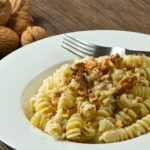WALNUT SAUCE, A LIGURIAN FRESH DELICACY

Traditionally, this walnut sauce was meant to be served with pansoti, typical Ligurian stuffed pasta, yet it is excellent with fusilli, potato gnocchi and other specialties.
In these super-hot summers 🔥 , we all need something fresh, a fast yet nice sauce that does not need cooking.
This walnut sauce, a delicious vegetarian dish, cannot be kept for more than 4-5 days in the fridge. Store it to a glass container and cover it with some olive oil.
Prep Time: 20 minutes | Cooking Time: 15 minutes | Total Time: 35 minutes | Yield: Makes 4 servings.
Ingredients
FOR THE STUFFING
- 20 walnuts, shelled
- ½ cup (100 g) cream or curd
- ¼ cup (30 g) grated Parmigiano
- ½ cup milk
- 2 tbsps olive oil
- 2 slices of stale bread, Ciabatta-style, deprived of the crust
- 1 tbsp fresh marjoram, minced
- ½ garlic clove
- Sea salt to tast
Instructions
In a small bowl, soak the bread in the milk. After 5 minutes, squeeze the milk out of the bread.
In a food processor, begin to mix the walnuts, garlic, bread and marjoram together. Add the other ingredients, oil and cream or curd in successive batches, mix for one minute, and the sauce is ready.
If you have a mortar, the ideal method is to mix all the ingredients together.
Often, the marjoram will turn brown. An excellent way to prevent this is to add a few ice cubes in the food processor or by keeping the food processor bowl in the freezer.
Traditionally, this sauce was meant to be served with pansoti, typical Ligurian stuffed pasta, yet it is excellent with potato gnocchi and other specialties.
In these super-hot summers, we all need something fresh, a fast yet nice sauce that does not need cooking.
This walnut sauce, a delicious vegetarian dish, cannot be kept for more than 4-5 days in the fridge. Store it to a glass container and cover it with some olive oil.






